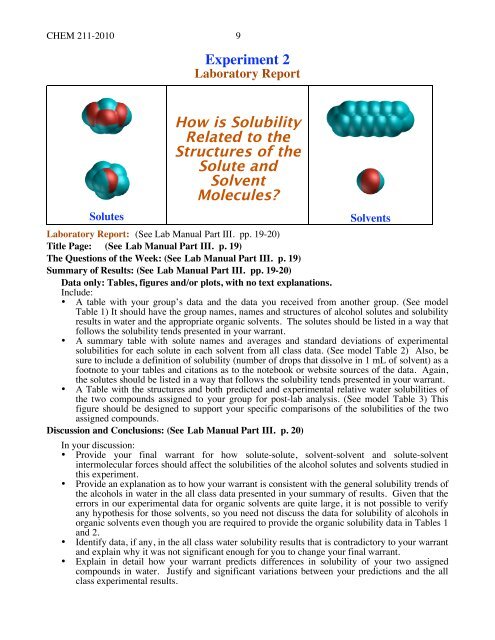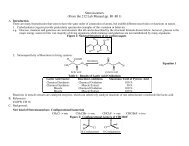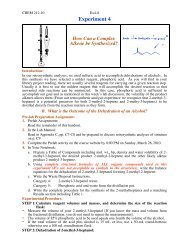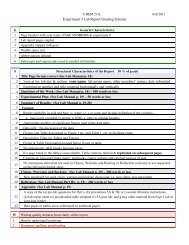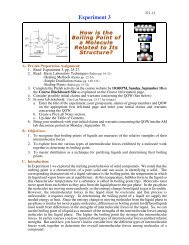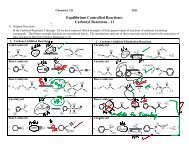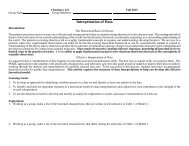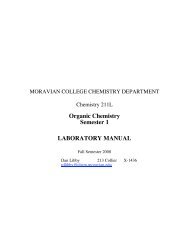Lab Report Format
Lab Report Format
Lab Report Format
Create successful ePaper yourself
Turn your PDF publications into a flip-book with our unique Google optimized e-Paper software.
CHEM 211-2010 9Experiment 2<strong>Lab</strong>oratory <strong>Report</strong>SolutesHow is SolubilityRelated to theStructures of theSolute andSolventMolecules?Solvents<strong>Lab</strong>oratory <strong>Report</strong>: (See <strong>Lab</strong> Manual Part III. pp. 19-20)Title Page: (See <strong>Lab</strong> Manual Part III. p. 19)The Questions of the Week: (See <strong>Lab</strong> Manual Part III. p. 19)Summary of Results: (See <strong>Lab</strong> Manual Part III. pp. 19-20)Data only: Tables, figures and/or plots, with no text explanations.Include:• A table with your group’s data and the data you received from another group. (See modelTable 1) It should have the group names, names and structures of alcohol solutes and solubilityresults in water and the appropriate organic solvents. The solutes should be listed in a way thatfollows the solubility tends presented in your warrant.• A summary table with solute names and averages and standard deviations of experimentalsolubilities for each solute in each solvent from all class data. (See model Table 2) Also, besure to include a definition of solubility (number of drops that dissolve in 1 mL of solvent) as afootnote to your tables and citations as to the notebook or website sources of the data. Again,the solutes should be listed in a way that follows the solubility tends presented in your warrant.• A Table with the structures and both predicted and experimental relative water solubilities ofthe two compounds assigned to your group for post-lab analysis. (See model Table 3) Thisfigure should be designed to support your specific comparisons of the solubilities of the twoassigned compounds.Discussion and Conclusions: (See <strong>Lab</strong> Manual Part III. p. 20)In your discussion:• Provide your final warrant for how solute-solute, solvent-solvent and solute-solventintermolecular forces should affect the solubilities of the alcohol solutes and solvents studied inthis experiment.• Provide an explanation as to how your warrant is consistent with the general solubility trends ofthe alcohols in water in the all class data presented in your summary of results. Given that theerrors in our experimental data for organic solvents are quite large, it is not possible to verifyany hypothesis for those solvents, so you need not discuss the data for solubility of alcohols inorganic solvents even though you are required to provide the organic solubility data in Tables 1and 2.• Identify data, if any, in the all class water solubility results that is contradictory to your warrantand explain why it was not significant enough for you to change your final warrant.• Explain in detail how your warrant predicts differences in solubility of your two assignedcompounds in water. Justify and significant variations between your predictions and the allclass experimental results.
CHEM 211 Experiment 3 10 SolubilityReflection: (See <strong>Lab</strong> Manual Part III. p. 20)As in Experiment 1 you developed your initial claims concerning answers to the QOW by comparingmolecular models of your small group of compounds. You then tested your claims by collectingsolubility data on the compounds. Your initial data analysis may have led you to adjust your claims toaccount for your group’s data. Finally you had the opportunity to further develop your claims byanalyzing a very large set of data from the whole class.As described in the lab manual, the reflection section of the report gives you the opportunity to tracethe development of your understanding throughout the process. You should start from your originalwarrant and explore how the experience with the data in the experiment helped you reach your finalwarrant for reasonable answers to the QOW.Appendix: (See <strong>Lab</strong> Manual Part III. p. 20)Include one copy of all handout sheets for Experiment 2 and all other items in the Experiment 2sections of your group members’ Data Binders.<strong>Lab</strong>oratory <strong>Report</strong> Due Date:Your lab report for Experiment 2 is due in your lab period between Tuesday, September 28 andThursday, September 30. (See <strong>Lab</strong> Manual Part I p. 4.)MethanolEthanolEtc.Model Table for Group Solubility ComparisonsTable 1: Comparison of Group Solubility Data between Red Sox and GiantsSolutes Red Sox Giants Red Sox GiantsName Structure Solubility inH 2 OSolubility inH 2 OSolubility inPentaneSolubility inNonaneSolutesMethanolEthanolEtc.Model Table for All Class Solubility DataTable 2: Summary of All-Class Solubility DataSolubility in Solubility in Solubility in Solubility in Solubility inH 2 OHexane Octane Decane DodecaneMean St. Mean St. Mean St. Dev Mean St. Dev Mean St.DevDevDevModel Table for Predicted vs. Experimental Solubilities of Assigned CompoundsTable 3: Comparison Solute Solubility Prediction and DataSoluteRelative Solubility in H 2 OName Structure Predicted Experimental2-pentanol 2 2.12-Methyl-1-propanol3 1.8


